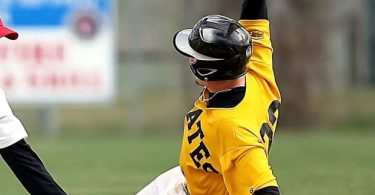The Situation:
There’s a runner on second with 2 outs in the bottom of the 13th inning. The visiting team is clutching to a 2-1 lead and trying to get the final out.
The Play:
The 1-1 fastball comes in at the top of the zone and the batter gets on top of it, hitting a hard ground ball past the pitcher and up the middle. The second baseman, shading to the right-handed hitter’s pull side ranges to his right and makes the backhanded stab. As he tries to come around the ball and get his feet under him, the second baseman loses his footing in the grass. Desperate, he jumps in the air trying to get his direction to first and gets off a hurried throw across his body.
The Outcome:
Despite the batter runner still being 40 feet from first base at the time, the second baseman’s hurried throw goes wide of the first base on the outfield side by about 20 feet. The first baseman can’t even get to the ball to knock it down and the ball goes all the way to the wall. The runner comes around to score the tying run from second and instead of walking back to the clubhouse in defeat, the offense has new life. They eventually win the game in the 18th inning.
What Went Wrong:
Does this situation sound familiar? It should! It happened during Game 3 of the 2018 World Series. Check out the exact play here. So, what should Kinsler have done differently?
It may seem like this error is physical and in the post-game news conference Kinsler even said, “In the act of throwing, I sailed it wide.” That is true, but we think the error here was actually that Kinsler decided to make the throw on the run the way he did. We aren’t trying to pick a fight with a gold glove defender, but we do want to highlight the fact that Kinsler had enough time to set his feet and make a strong throw in time to get Puig at first. Thanks to the following research from @TangoTiger, we can definitively say that Kinsler had enough time (.5 seconds) to gather himself and still throw Puig out with a throw to first of average velocity for a second baseman. Check out the breakdown here:
https://twitter.com/_LifeOfTy_/status/1056063583971241985
What this play, and others like it come down to is the ability to develop a strong internal clock. That means that as a fielder, you have a strong awareness of how much time you have to make a play considering a number of variables (batter speed, ball speed, arm strength, unexpected outcomes, position on the field, etc.) as they unfold. It’s the little voice in your head that tells you to hurry or take your time on a given play. The more precise the internal clock, the better you can use your time on defense to make the high percentage play. So while Kinsler’s lapse in judgment is an uncommon mistake for him, it is a great lesson for all infielders about the value of developing a strong internal clock. This is a skill that can and should be worked on in training and improved.
There are many ways to improve your internal timing, including live reps with runners getting down the line. An easier and less involved way to get similar feedback to a runner requires only an extra player or coach and a stopwatch. You can set the speed of your runner, say a blazing fast runner who will get down the line in 3.9 seconds, and take reps with the person on the stopwatch calling out the time it takes you to get the ball to first base from the time it is hit off the fungo or shot out of a machine. This instant feedback will allow your mind and body to calibrate the internal clock and improve your self-awareness as a defender. Once your clock is improved, it becomes a matter of knowing the speed of the batter runner, doing your pre-game and pre-pitch homework, and thinking the game!







